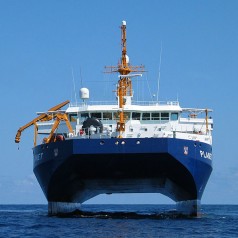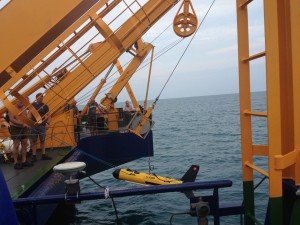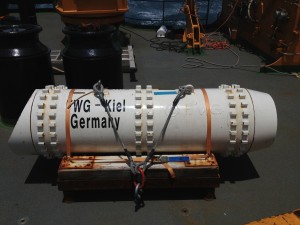Acoustics on a SWATH vessel

The best part about studying oceanography is the need to experience the ocean fi rst hand. In order to fulfill the requirements of my Oceanography Master’s degree, I had the opportunity to spend two weeks at sea. In the middle of May, I flew from Halifax to Fort Lauderdale, Florida and boarded the R/V Planet, which would take me on a tour of the waters off the Atlantic coast of Florida, then up the eastern seaboard of the United States, and back to Halifax.
The R/V Planet is unlike any ship that I have ever seen. The ship is owned by FWG (WTD 71), a German naval research organization. While at fi rst glance it appears to be a type of catamaran, it is actually a SWATH (Small Waterplane Area Twin Hull) vessel. The main diff erence between the two is in the volume of the ship that comes in contact with wave energy. Both ships are stabilized by twin hulls, but a catamaran has two conventional hulls, while a SWATH ship’s design is more like a platform built on top of two submarines. Because of this, only the parts of the ship that connect the platform to the submarines will be affected by wave energy. This makes the R/V Planet very stable in rough seas, which is beneficial for acoustic research work. Additional measures, such as suspending the ship’s diesel generators on springs, have been taken to minimize ship noise that may contaminate acoustic measurements.
This was the R/V Planet’s first trip across the Atlantic Ocean to collaborate with American scientists. The goal of our expedition was to better understand how mines bury in carbonate sediments and to classify the seafloor off the coast of Cape Canaveral, Florida, where carbonate sediments are known to be abundant. Additionally, we were able to collect information to expand dbSeabed, a database managed by Dr. Chris Jenkins (University of Colorado at Boulder) that provides geographic seafloor substrate data by compiling thousands of individual datasets.
We collected our data primarily using 3 instruments: 1. sidescan sonar, 2. a van Veen grab, and 3. a Burial Recording Mine produced by FWG. An underwater camera was also deployed as an additional means of ground truthing. The sidescan sonar provided images of the seafloor by transmitting a fan-shaped sound beam and interpreting the acoustic backscatter, or echoes, returned to the receiver. The sidescan data allowed us to categorize the seafloor by it’s acoustic profile. Grab samples were collected periodically along short transects to determine the relationship between actual seafloor properties and the acoustic backscatter data collected by the sidescan. For example, we observed higher backscatter in regions with courser grains and lower backscatter in regions with fi ner grains. We also deployed a Mine Burial Recorded (MBR), a tool developed by FWG to test seafloor mine burial. The MBR uses the case of an old mine that has three rings of light sensors attached. As the mine buries, the light sensors become covered and it is possible to tell how deeply the mine penetrated the seafloor.
What an experience!

Deploying the sidescan sonar from the R/V Planet.

The Mine Burial Recorder (MBR) developed by FWG – Kiel.

